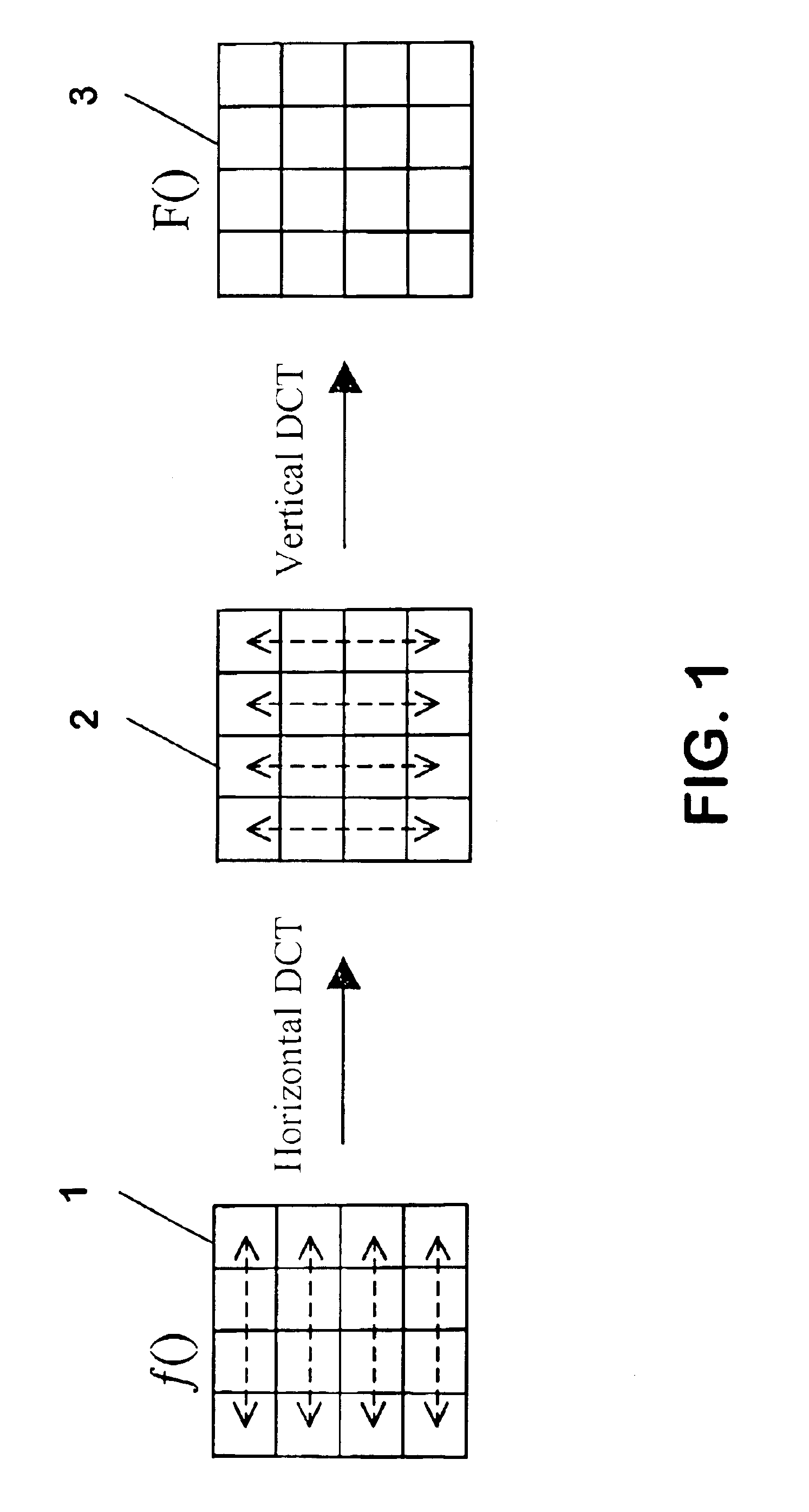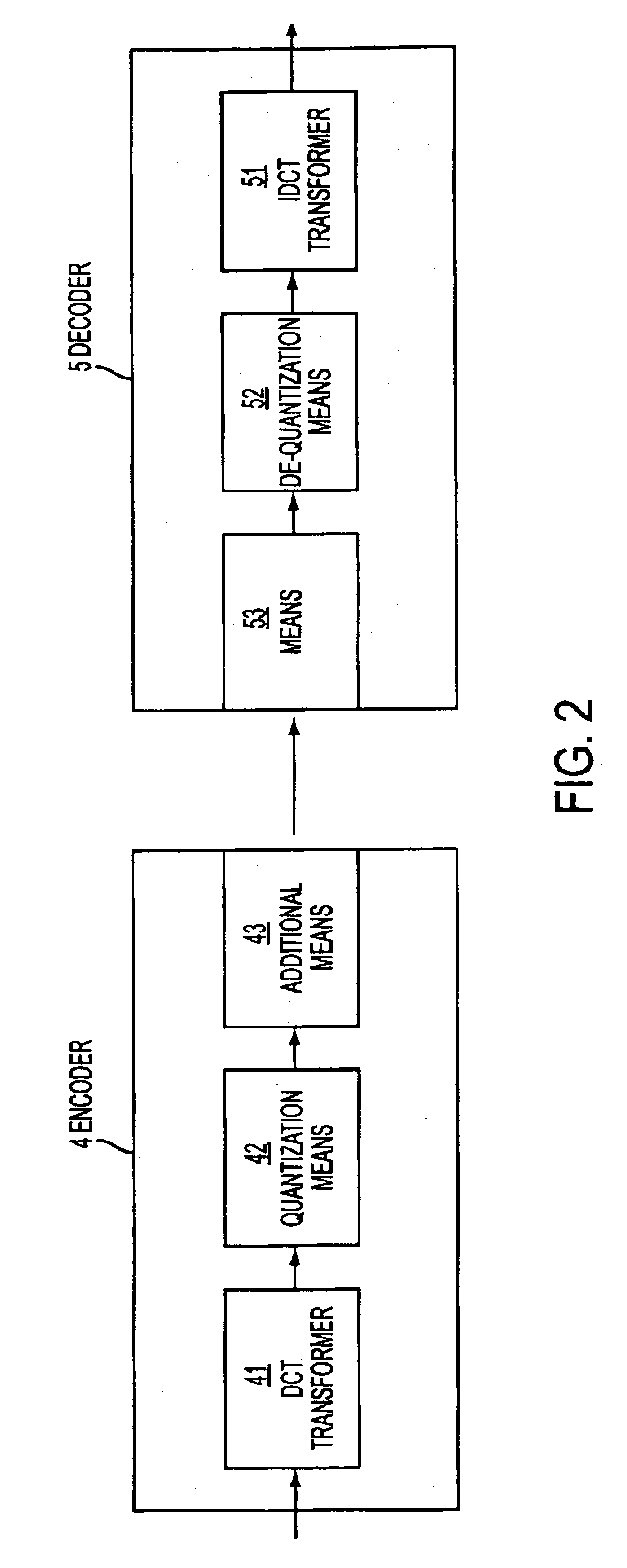Implementation of a transform and of a subsequent quantization
a transform and quantization technology, applied in the field of digital data processing, can solve the problems of large transforms, which also involve many non-trivial multiplications, increase the word width, and require additional accuracy in bits, so as to reduce the number of required operations, and save processor time
- Summary
- Abstract
- Description
- Claims
- Application Information
AI Technical Summary
Benefits of technology
Problems solved by technology
Method used
Image
Examples
##fbabfbabfbabfbabfbabfbabfbabfb
[0095]Since B is a diagonal matrix, the above equation can, as in the 4×4 case, be written as Y=D⊗(CXCT)⊗DT=[aaaaaaaabbbbbbbbffffffffbbbbbbbbaaaaaaaabbbbbbbbffffffffbbbbbbbb]⊗(CXCT)⊗[abfbabfbabfbabfbabfbabfbabfbabfbabfbabfbabfbabfbabfbabfbabfbabfb]
where {circle around (X)} is used to indicate that the respective two matrices are multiplied entry-wise instead of a full matrix multiplication.
[0096]After combining D and its transposed form DT into E, the final DCT is: Y=(CXCT)⊗E=([111111111cbdbeb-eb-db-cb-11gf-gf-1-1-gfgf1cb-eb-1-dbdb1eb-cb1-1-111-1-11db-1ebcb-cb-eb1-dbgf-11-gf-gf1-1gfeb-dbcb-11-cbdb-eb]·X·CT)⊗[ a2a ba fa ba2a ba fa ba bb2b fb2a bb2b fb2a fb ff2b fa fb ff2b fa bb2b fb2a bb2b fb2a2a ba fa ba2a ba fa ba bb2b fb2a bb2b fb2a fb ff2b fa fb ff2b fa bb2b fb2a bb2b fb2]=YC⊗E
[0097]In a next step, the coefficients cb, db, eb and gf are converted into a fixed-point format which can be represen...
third embodiment
[0103]According to the invention, the approximations are adjusted for the condition ATA=I by optimizing the selection of fractional numbers in the transform. The fractional numbers are selected so that the off-diagonal elements of the matrix ATA are as close to zero as possible in the implementation sense The solution of the optimization is limited to a Dirichlet set, i.e., to certain rational numbers.
fourth embodiment
[0104]According to the invention approximations of a fast-DCT algorithm are adjusted for the condition ATA=I by optimizing the selection of fractional numbers in the transform.
[0105]In the whole, it becomes apparent from the described embodiments of the invention that efficient alternative implementations for compressing digital data are presented. The implementation can be realized to be either more accurate than known implementations or faster or both.
PUM
 Login to View More
Login to View More Abstract
Description
Claims
Application Information
 Login to View More
Login to View More - R&D
- Intellectual Property
- Life Sciences
- Materials
- Tech Scout
- Unparalleled Data Quality
- Higher Quality Content
- 60% Fewer Hallucinations
Browse by: Latest US Patents, China's latest patents, Technical Efficacy Thesaurus, Application Domain, Technology Topic, Popular Technical Reports.
© 2025 PatSnap. All rights reserved.Legal|Privacy policy|Modern Slavery Act Transparency Statement|Sitemap|About US| Contact US: help@patsnap.com



